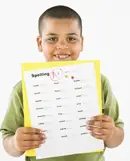As the end of the school year approaches, artistic creations, book reports, poster boards, folders and workbooks arrive home. Your child hands each one to you with an expectant look on his face: “You’re going to keep this, right?”
Well… are you? 
To a child, everything she creates is worth saving, but you might not be as sure. The amount of “work” produced by even one child can take over your home. How do you decide what to keep, what do you tell your child, and how do you dispose of the “throwaway” items in a way that will not upset your child?
There is the “wrap it in newspaper” technique, the “push in to the bottom of the garbage can” method, and my personal favorite, the “wait until he leaves for school, put it out on garbage day and hope he doesn’t notice it’s missing” system. But while these options do reduce clutter, they actually miss the point.
It is far better to go through your child’s work with your child’s help. This is an opportunity to help your child learn an important life lesson: not every single piece of work she produces is perfect or worth saving. In fact, not everything one does in life is truly amazing — we all need to learn this. You will teach your child that when she tries hard or produces work that is unique, you will be thrilled to save it, but that not everything fits these criteria. This instills humility and the ability to be self-critical.
It also shows him that when you do place value on a piece of work, it is because you think it is unusually good work, and you are not saving it simply because he created it. Your child is much more likely to value and trust your opinion when he knows you don’t offer praise indiscriminately about everything, that you are selective and genuine. He may not be happy that you don’t want to keep everything, but he will become more confident, self-reflective and hard-working if you help him see that some work is worth saving, but not all.
Note that if your child is really young — under 5 — the sneakier methods of disposal may still work best. Also, when a child has an especially difficult time parting with his creations, offer him a box to keep in his room for whatever he wants to save, even if you don’t want it. Below are guidelines for what is worth keeping and what to throw out.
• Toss worksheets and workbooks. Explain that they don’t show your child’s creativity.
• Throw away large poster boards because they will likely be curled up, unglued and dusty by the end of the summer unless you have proper storage space. These are sometimes hard to part with so may remain in the child’s room for a while.
• Throw away weekly book reports, but save major reports.
• Save 3-D projects until they fall apart. Some last weeks, others, years.
• Save only artwork that required effort or that is meaningful to you. Hang it up, framed or unframed.
• Toss tests (even 100s and As).
• Save only the final report card.
• Throw away homework/class binders.
If you pursue this purging throughout the school year, your child will become accustomed to it, making the end of the year easier. In fact, these days, my children often toss out old spelling tests and homework assignment themselves. Hallelujah!
DR. SUSAN BARTELL is a nationally recognized child, teen and parenting psychologist and award-winning author. Her latest book is Dr. Susan’s Girls-Only Weight Loss Guide. You can learn more about Dr. Bartell at www.drsusanbartell.com.





















